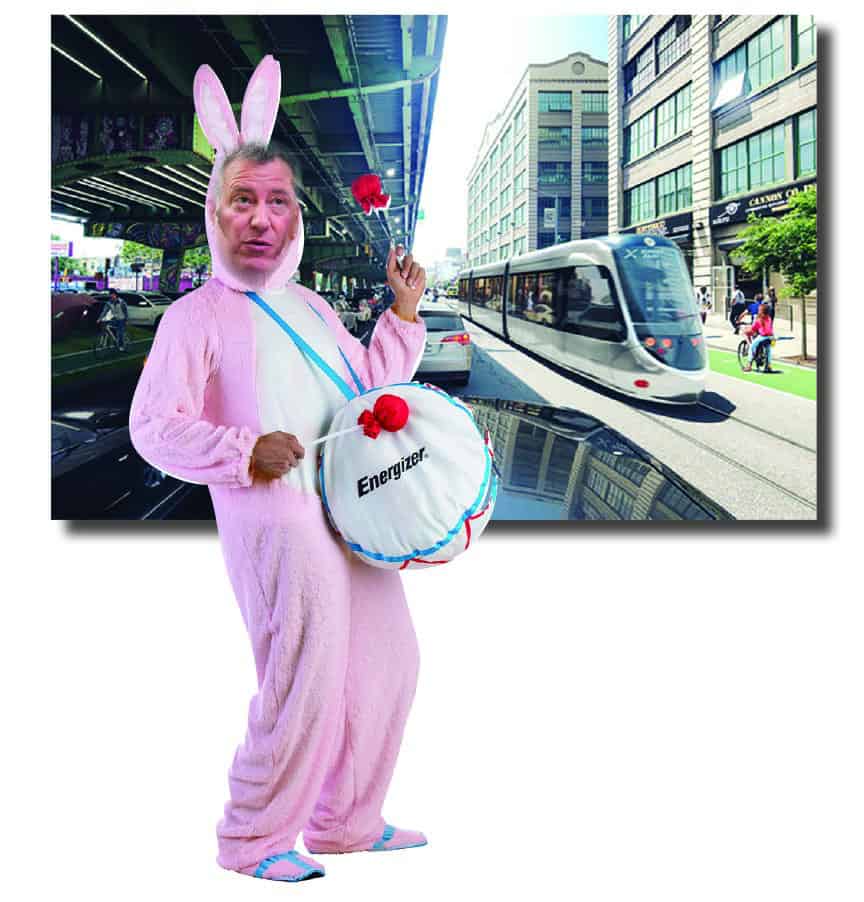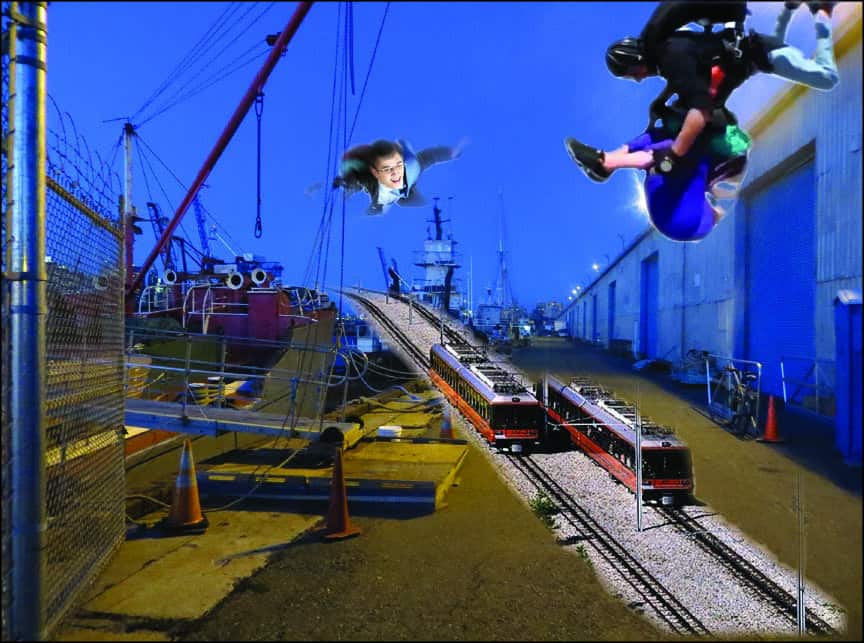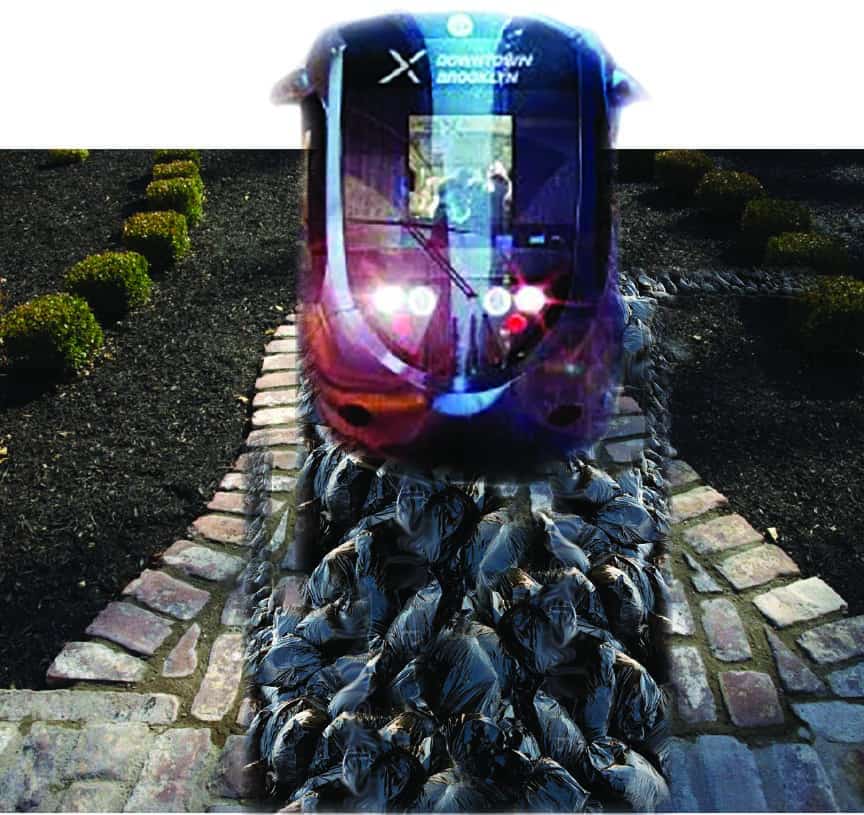After announcing his ambitious plan to build a trolley system in February, Mayor Bill de Blasio has been touring the neighborhoods of his real estate buddies where the streetcar might possibly double, triple or quadruple their property values.

In March, he graced Red Hook with his appearance. Although he has no known major campaign donors in the area, he was hoping – in lieu of the neighborhood’s new popularity among developers – to make new friends.
The less important reason he stopped by was to give Red Hookers details about the changing landscape of their coveted community. He was also overheard whispering to an administration official,
“What a fantastic photo op!” while his microphone was still live.
With charts, posters, reports, a PowerPoint presentation, hot chocolate and warm cookies he baked himself, the mayor began by saying, “Let’s be clear: I like trains – especially big ones.”
Mayor de Blasio went on to provide much anticipated details about how the people would flock to his coastal catastrophe. Unusually logical, his first report and hand-drawn poster addressed ways to work around the MTA’s refusal to allow transfers.
“The MTA is making this process more difficult by thwarting my half-baked ideas,” he began. “However, we have developed other methods to work around their stubborn refusal to see it my way. Smiley face, please don’t read the emojis again this time, your Honor… Oops!”
Editor’s note: The Blue Pencil Lunar-Revue has intentionally not reported on the slides of a crying de Blasio and his whining about how everyone hates him that immediately followed his issues with the MTA.
The mayor went on to describe how every passenger seat whether “luxury” or “affordable” would be equipped with ejector switches and complimentary parachutes that would propel straphangers “near” or “close to” existing subway and bus stops, including the currently defunct 2nd Avenue line.
“The US Coast Guard will be on constant alert for passengers trying to connect from the streetcar to lines in Manhattan and Staten Island. We know that initially there will be issues to deal with, but in the end, we expect the survival rate to be somewhere between 89-96%.
“We anticipate a few hundred thousand passengers may land in local waterways while getting used to the new traffic patterns; it’s a major adjustment. I applaud the Coast Guard in advance for the thousands of lives they will save with this new initiative we are calling ‘Zero Swimmers’,” de Blasio said.

Affordable component
When pressed on what he meant by affordable and luxury cars, the mayor explained that, “We live in a ‘Tale of Two Cities.’ We must be willing to provide accommodations for both of those cities if we are going to coexist in the same communities.”
He went on to explain that 30% of the cable cars would be affordable, while the remaining ones would be designated for luxury passengers. “We’re not going to make this process complicated,” he said. “You won’t have to file tax forms or provide documentation to identify which car you’re allowed to ride in. Straphangers who are wearing shiny shoes will be eligible to ride in the luxury cars; if you are wearing dusty boots, I think it only makes sense that you belong on the affordable cars.”
The cost of both cars will be exactly the same. However there are a few distinctions between the designs. Luxury cars will be outfitted with velvet seat cushions, an open bar and a live jazz band.
Seats will be available for all luxury riders. Affordable cars will have less seats available, less qualified drivers, and all passengers will be required to enter and exit through the rear door.
As part of another his city-wide initiatives, de Blasio also promised the streetcar line would be run by green energy. “We’re in the midst of securing the biggest contract with Energizer that their company has ever seen. I got the idea from a SuperBowl commercial nearly 20 years ago when I saw how long that bunny would run.”
The trolley system will operate on a single rail, propelled through the streets and sky by solar, wind and battery power. “Of course there will be days when it is rainy, so the solar power will need to be backed up. There will be days without wind, and we’ll need a contingency plan for that. When the greatest city on the planet faces blackout possibilities, we’ll be able to bring out two Energizer Bunnies. One will pull the car from the front; the other will push from the back. It’s really just simple physics, people,” the mayor explained.
Trolley will make up for loss of hospital that mayor couldn’t save
Mayor de Blasio also promised to use the street car line to bring vital services to underserved communities, like Red Hook. In the 2013 Long Island College Hospital (LICH) debacle, the mayor was arrested protesting its closure. After promising to keep a “full-service hospital” for the neighborhood, he quickly reneged after his Pre-K plan was adopted by Governor Cuomo. He insists that he will continue pushing for “healthcare services” for Red Hook.
In an effort to fulfill his wavering promise, one trolley will be equipped with medical professionals, hi-tech medical equipment, and emergency medical supplies. Loud sirens and bright emergency lights will be running at all times through the streets – all day, every day.
This medic car will make the loop every 87 minutes, so that those requiring immediate attention will not have to wait more than an hour and a half. Anyone who needs emergency services will be able to track the traveling urgent care center on their smartphones. If the emergency is actually an emergency, patients will be able to jump aboard the moving car and dangle from a handrail until the streetcar reaches its next stop. The Jaws of Life will be available at all stops to unclench their death grips from convenient outside handrails.
An exasperated resident expressed concern over the disruption over the lights and noise. “How will we ever get any rest – any peace and quiet?!?” she demanded.
In response, Mayor de Blasio said, “We’ll make every effort to make sure every hard-working community has at least 78 minutes of quiet time between. And if the trolley system runs as reliably as the B61 bus, we’re more likely to see 3 to 4 hours between non-disruptive time.”
Another concerned member of the community questioned the mayor on the reliability of the emergency services. “You stated before that we wouldn’t have to wait more than an hour and a half; now you’re saying in could be as long as 4 hours. How long will somebody suffering from a life-threatening ailment survive waiting for emergency trolley services?”
“Look, we know it’s not a perfect system. Things are always going to go wrong. We’ll deal with these issues as they arise,” the mayor answered.
More specific to the Red Hook area, de Blasio announced that a portion of the track would be a “loop-de-loop” giving riders “the thrill of a lifetime” on a “daily basis.” The double loop portion of the route will span the width of the Atlantic Basin. According to the mayor’s graphs, charts and doodles, this part of the trolley line is essential “to prevent the cost of the entire remarkable project from going completely over-budget. By eliminating a segment of track that has to go across land, we will save hundreds of taxpayers’ pennies.”

Office of Design & Construction
When asked by a member of the media why the route across the Basin couldn’t be a simple straight path over the body of water, de Blasio explained, “We have teams of really smart designers that have lain out all of our options. We have to think about not just some New Yorkers, but all New Yorkers – including the thrill-seekers of our great city.”
A persistent media member asked if de Blasio was aware of the new Gowanus sewage park, he affirmed that he had. “We want the whole of Brooklyn to be one big amusement park. That’s the kind of world New Yorkers want to live in.”
Another issue is how the trolley system will be able to survive the crumbling cobblestones along the proposed path. “We’ve thought through every element of this many times over,” the mayor began. “I think many of you will appreciate the ingenuity of the plan. We’re going to bring back the garbage sites to Red Hook – but this time in a more positive, more progressive way. Many of the citizens here fought to have them removed because they served no purpose. But, this time, they will be serving a beautifully proposed proposal.”
The rail system will be built upon up to eight feet of landfill along the right side of cobbled streets. The rail lines will be built atop the mounds of stinky garbage. The piles may be unstable at first, but will stabilize after the first couple of years. Until then, Mayor de Blasio warns that riders may experience “slight-to-moderate turbulence” but nothing “too extreme.”
The DOT initially expressed two areas of concern for the trashy idea. The first focused on the debris that would fall to into the driving lanes. Expert scientists determined it would be necessary to run Sanitation trucks through the area every 6 hours. Eliminating all parking spaces on these streets would allow for more truck traffic and constant street-sweeping.
The second issue DOT took gumption with was the fire hazard. The mayor convinced them that the only flammable items New Yorkers get rid of are made of paper. “If we start seeing a rise in the number of gas cans being thrown away, we’ll reconsider our options. But right now, we should be recycling all paper products anyway.”
Meetings to add refinements
The next step in the building of the trolleys is to hold completely pointless community meetings to suggest ideas that the city’s administration has no intention of listening to. A series of experts will be brought into these meetings to discuss how to build greenhouses out of CD cases, America’s favorite pie recipes, and other non-relevant topics.









One Comment
Coast Guard will be picking up a lot of people trying to connect with lines on Staten Island… because there are no lines on Staten Island! For years those people have been begging the city to re-open the one train line that used to be there on the north side of the island, only to be ignored. This trolley scheme (aka luxury real estate developers marketing tool) is a big huge slap in the face to the only borough still with no public transportation to speak of.